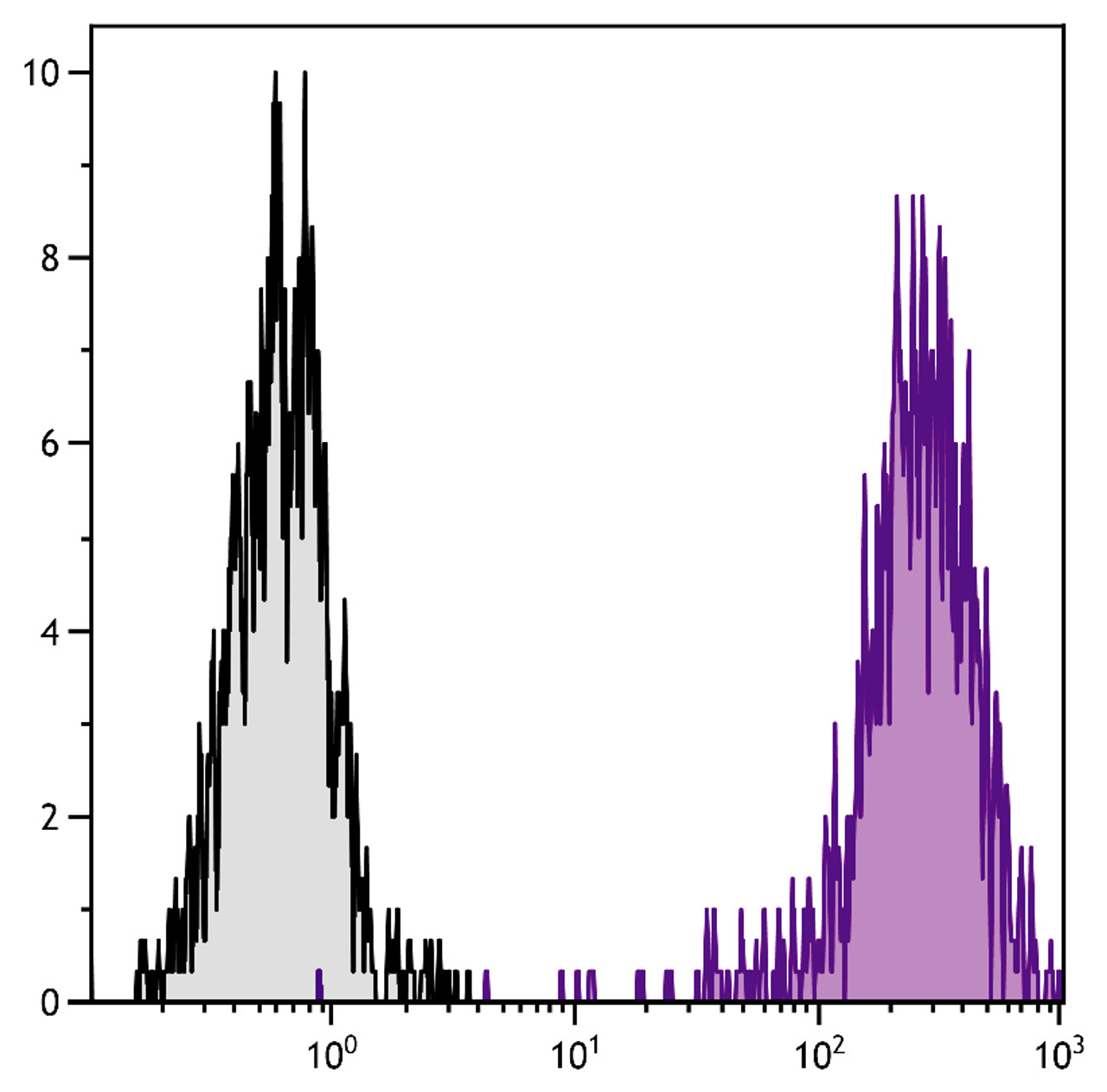Product Description
CD25 Antibody [3C7] (APC) | 98-709 | ProSci
Host: Rat
Reactivity: Mouse
Homology: N/A
Immunogen: IL-2 dependent BALB/c helper T cell clone HT2
Research Area: Immunology
Tested Application: Flow
Application: CD25 Antibody [3C7] for use in flow cytometry assays.
Specificiy: CD25
Positive Control 1: N/A
Positive Control 2: N/A
Positive Control 3: N/A
Positive Control 4: N/A
Positive Control 5: N/A
Positive Control 6: N/A
Molecular Weight: N/A
Validation: N/A
Isoform: N/A
Purification: N/A
Clonality: Monoclonal
Clone: [3C7]
Isotype: IgG2b
Conjugate: APC
Physical State: Liquid
Buffer: Supplied in PBS/NaN3 and a stabilizing agent
Concentration: 0.1 mg/mL
Storage Condition: Store vial at 2-8˚C
Alternate Name: IL-2Ralpha, p55, IL-2 receptor alpha chain, Ly-43, Tac, IL-2-RA
User Note: Optimal dilutions for each application to be determined by the researcher.
BACKGROUND: The IL-2 receptor (IL-2R) exists in three alternative forms made up from the individual components of CD25, CD122, and CD132. CD25 represents the low affinity alpha chain of the IL-2R, a type I transmembrane glycoprotein containing two CCP domains. It is rich in O-linked carbohydrates and has a short cytoplasmic tail. CD25 is expressed on activated T cells, B cells, NK cells, and monocytes of all mouse strains tested. Expression of CD25 on activated T lymphocytes is transitory and endogenously regulated. CD25 is expressed on precursor B cells in bone marrow. Its expression is initiated by functional rearrangement and expression of IgM heavy chain genes and is down-regulated when immature B cells mature and express IgD. It is expressed at a higher level on CD4+CD8+ thymocytes. It is also expressed on cultured epidermal Langerhans cells. The biochemical features of murine CD25 have been characterized in detail. The 3C7 monoclonal antibody reacts with an epitope of CD25 which is distinct from that recognized by clone 7D4. 3C7, used in combination with 7D4 in culture, results in higher levels of inhibition of proliferation driven by IL-2 and generation of alloreactive CTL than either of these monoclonal antibodies alone.
 Euro
Euro
 USD
USD
 British Pound
British Pound
 NULL
NULL

![CD25 Antibody [3C7] (APC) CD25 Antibody [3C7] (APC)](https://cdn11.bigcommerce.com/s-452hpg8iuh/images/stencil/1280x1280/products/576079/813637/porsci_lo__79508.1648973713__13681.1649092118.png?c=2)

![CD25 Antibody [3C7] (APC) CD25 Antibody [3C7] (APC)](https://cdn11.bigcommerce.com/s-452hpg8iuh/images/stencil/100x100/products/576079/813637/porsci_lo__79508.1648973713__13681.1649092118.png?c=2)

![CD25 Antibody [3C7] (APC) CD25 Antibody [3C7] (APC)](https://cdn11.bigcommerce.com/s-452hpg8iuh/images/stencil/500x659/products/576079/813637/porsci_lo__79508.1648973713__13681.1649092118.png?c=2)
![CD25 Antibody [3C7] CD25 Antibody [3C7]](https://cdn11.bigcommerce.com/s-452hpg8iuh/images/stencil/500x659/products/576509/814337/porsci_lo__79508.1648973713__88662.1649092213.png?c=2)
![CD25 Antibody [3C7] CD25 Antibody [3C7]](https://cdn11.bigcommerce.com/s-452hpg8iuh/images/stencil/500x659/products/576506/814333/porsci_lo__79508.1648973713__73599.1649092212.png?c=2)
![CD25 Antibody [3C7] (Biotin) CD25 Antibody [3C7] (Biotin)](https://cdn11.bigcommerce.com/s-452hpg8iuh/images/stencil/500x659/products/576508/814335/porsci_lo__79508.1648973713__45833.1649092213.png?c=2)
![CD25 Antibody [3C7] (FITC) CD25 Antibody [3C7] (FITC)](https://cdn11.bigcommerce.com/s-452hpg8iuh/images/stencil/500x659/products/576507/814334/porsci_lo__79508.1648973713__31343.1649092212.png?c=2)
![CD25 Antibody [3C7] (PE) CD25 Antibody [3C7] (PE)](https://cdn11.bigcommerce.com/s-452hpg8iuh/images/stencil/500x659/products/576078/813635/porsci_lo__79508.1648973713__68973.1649092118.png?c=2)